Report on Negotiation Approaches: Competitive and Problem-Solving
VerifiedAdded on 2023/06/12
|12
|2778
|60
Report
AI Summary
This report provides a comparative analysis of two primary negotiation approaches: competitive positional-based negotiation and problem-solving interest-based negotiation. It delves into the assumptions underlying each approach, highlighting that competitive negotiation operates on a zero-sum game principle with a focus on material gains and insignificant relationships, while problem-solving negotiation emphasizes mutual understanding and innovative solutions. The report identifies risks associated with each approach, such as the potential for distrust and damaged relationships in competitive negotiation and the challenges in accurately estimating risks in problem-solving negotiation. Ultimately, the report concludes that the problem-solving interest-based approach is more appropriate due to its promotion of creativity, improved relationships, and focus on justice and legitimacy. Desklib offers a platform to access this and other solved assignments for students.

Bachelors of business
Paraphrase This Document
Need a fresh take? Get an instant paraphrase of this document with our AI Paraphraser
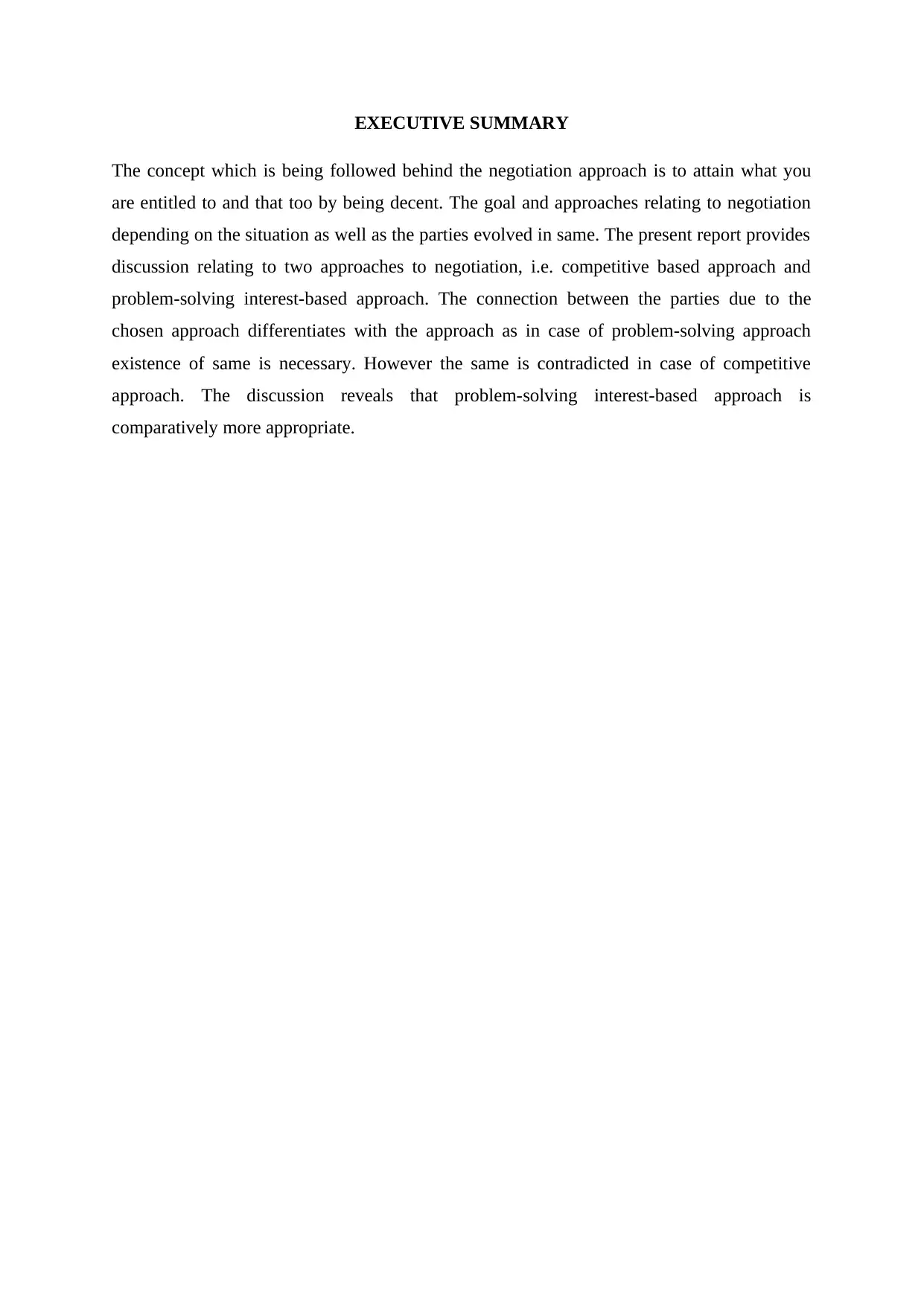
EXECUTIVE SUMMARY
The concept which is being followed behind the negotiation approach is to attain what you
are entitled to and that too by being decent. The goal and approaches relating to negotiation
depending on the situation as well as the parties evolved in same. The present report provides
discussion relating to two approaches to negotiation, i.e. competitive based approach and
problem-solving interest-based approach. The connection between the parties due to the
chosen approach differentiates with the approach as in case of problem-solving approach
existence of same is necessary. However the same is contradicted in case of competitive
approach. The discussion reveals that problem-solving interest-based approach is
comparatively more appropriate.
The concept which is being followed behind the negotiation approach is to attain what you
are entitled to and that too by being decent. The goal and approaches relating to negotiation
depending on the situation as well as the parties evolved in same. The present report provides
discussion relating to two approaches to negotiation, i.e. competitive based approach and
problem-solving interest-based approach. The connection between the parties due to the
chosen approach differentiates with the approach as in case of problem-solving approach
existence of same is necessary. However the same is contradicted in case of competitive
approach. The discussion reveals that problem-solving interest-based approach is
comparatively more appropriate.
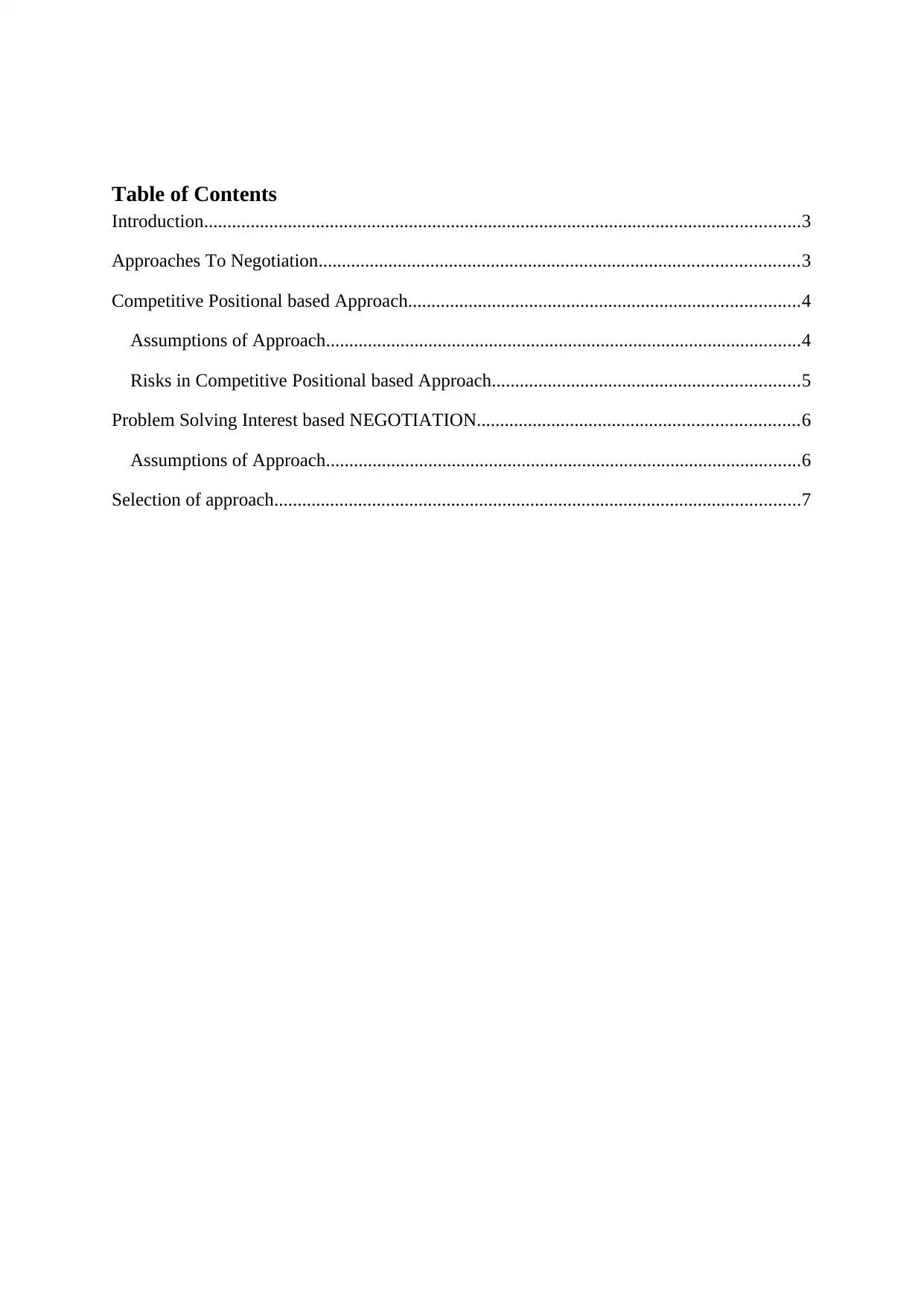
Table of Contents
Introduction................................................................................................................................3
Approaches To Negotiation.......................................................................................................3
Competitive Positional based Approach....................................................................................4
Assumptions of Approach......................................................................................................4
Risks in Competitive Positional based Approach..................................................................5
Problem Solving Interest based NEGOTIATION.....................................................................6
Assumptions of Approach......................................................................................................6
Selection of approach.................................................................................................................7
Introduction................................................................................................................................3
Approaches To Negotiation.......................................................................................................3
Competitive Positional based Approach....................................................................................4
Assumptions of Approach......................................................................................................4
Risks in Competitive Positional based Approach..................................................................5
Problem Solving Interest based NEGOTIATION.....................................................................6
Assumptions of Approach......................................................................................................6
Selection of approach.................................................................................................................7
⊘ This is a preview!⊘
Do you want full access?
Subscribe today to unlock all pages.

Trusted by 1+ million students worldwide
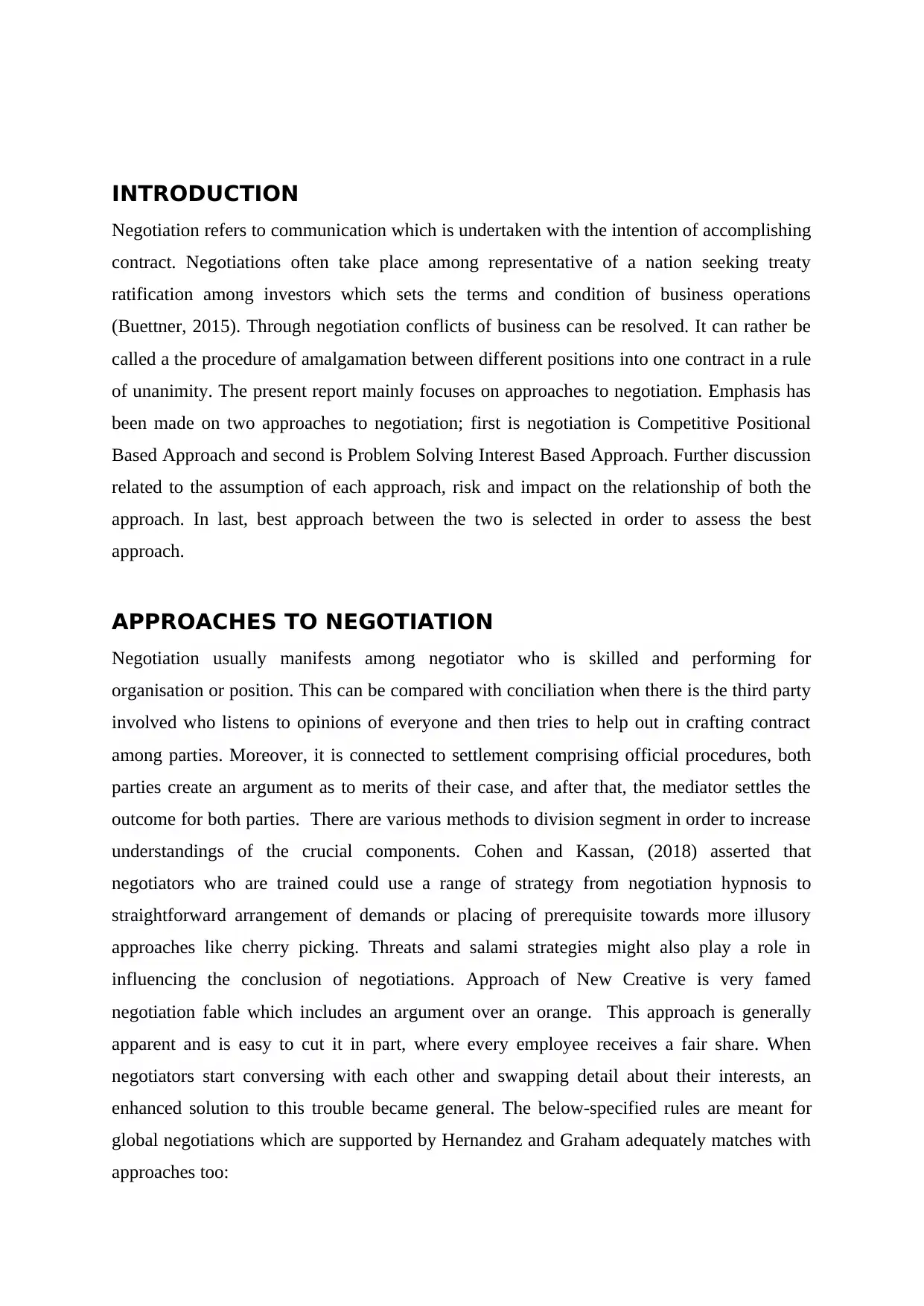
INTRODUCTION
Negotiation refers to communication which is undertaken with the intention of accomplishing
contract. Negotiations often take place among representative of a nation seeking treaty
ratification among investors which sets the terms and condition of business operations
(Buettner, 2015). Through negotiation conflicts of business can be resolved. It can rather be
called a the procedure of amalgamation between different positions into one contract in a rule
of unanimity. The present report mainly focuses on approaches to negotiation. Emphasis has
been made on two approaches to negotiation; first is negotiation is Competitive Positional
Based Approach and second is Problem Solving Interest Based Approach. Further discussion
related to the assumption of each approach, risk and impact on the relationship of both the
approach. In last, best approach between the two is selected in order to assess the best
approach.
APPROACHES TO NEGOTIATION
Negotiation usually manifests among negotiator who is skilled and performing for
organisation or position. This can be compared with conciliation when there is the third party
involved who listens to opinions of everyone and then tries to help out in crafting contract
among parties. Moreover, it is connected to settlement comprising official procedures, both
parties create an argument as to merits of their case, and after that, the mediator settles the
outcome for both parties. There are various methods to division segment in order to increase
understandings of the crucial components. Cohen and Kassan, (2018) asserted that
negotiators who are trained could use a range of strategy from negotiation hypnosis to
straightforward arrangement of demands or placing of prerequisite towards more illusory
approaches like cherry picking. Threats and salami strategies might also play a role in
influencing the conclusion of negotiations. Approach of New Creative is very famed
negotiation fable which includes an argument over an orange. This approach is generally
apparent and is easy to cut it in part, where every employee receives a fair share. When
negotiators start conversing with each other and swapping detail about their interests, an
enhanced solution to this trouble became general. The below-specified rules are meant for
global negotiations which are supported by Hernandez and Graham adequately matches with
approaches too:
Negotiation refers to communication which is undertaken with the intention of accomplishing
contract. Negotiations often take place among representative of a nation seeking treaty
ratification among investors which sets the terms and condition of business operations
(Buettner, 2015). Through negotiation conflicts of business can be resolved. It can rather be
called a the procedure of amalgamation between different positions into one contract in a rule
of unanimity. The present report mainly focuses on approaches to negotiation. Emphasis has
been made on two approaches to negotiation; first is negotiation is Competitive Positional
Based Approach and second is Problem Solving Interest Based Approach. Further discussion
related to the assumption of each approach, risk and impact on the relationship of both the
approach. In last, best approach between the two is selected in order to assess the best
approach.
APPROACHES TO NEGOTIATION
Negotiation usually manifests among negotiator who is skilled and performing for
organisation or position. This can be compared with conciliation when there is the third party
involved who listens to opinions of everyone and then tries to help out in crafting contract
among parties. Moreover, it is connected to settlement comprising official procedures, both
parties create an argument as to merits of their case, and after that, the mediator settles the
outcome for both parties. There are various methods to division segment in order to increase
understandings of the crucial components. Cohen and Kassan, (2018) asserted that
negotiators who are trained could use a range of strategy from negotiation hypnosis to
straightforward arrangement of demands or placing of prerequisite towards more illusory
approaches like cherry picking. Threats and salami strategies might also play a role in
influencing the conclusion of negotiations. Approach of New Creative is very famed
negotiation fable which includes an argument over an orange. This approach is generally
apparent and is easy to cut it in part, where every employee receives a fair share. When
negotiators start conversing with each other and swapping detail about their interests, an
enhanced solution to this trouble became general. The below-specified rules are meant for
global negotiations which are supported by Hernandez and Graham adequately matches with
approaches too:
Paraphrase This Document
Need a fresh take? Get an instant paraphrase of this document with our AI Paraphraser
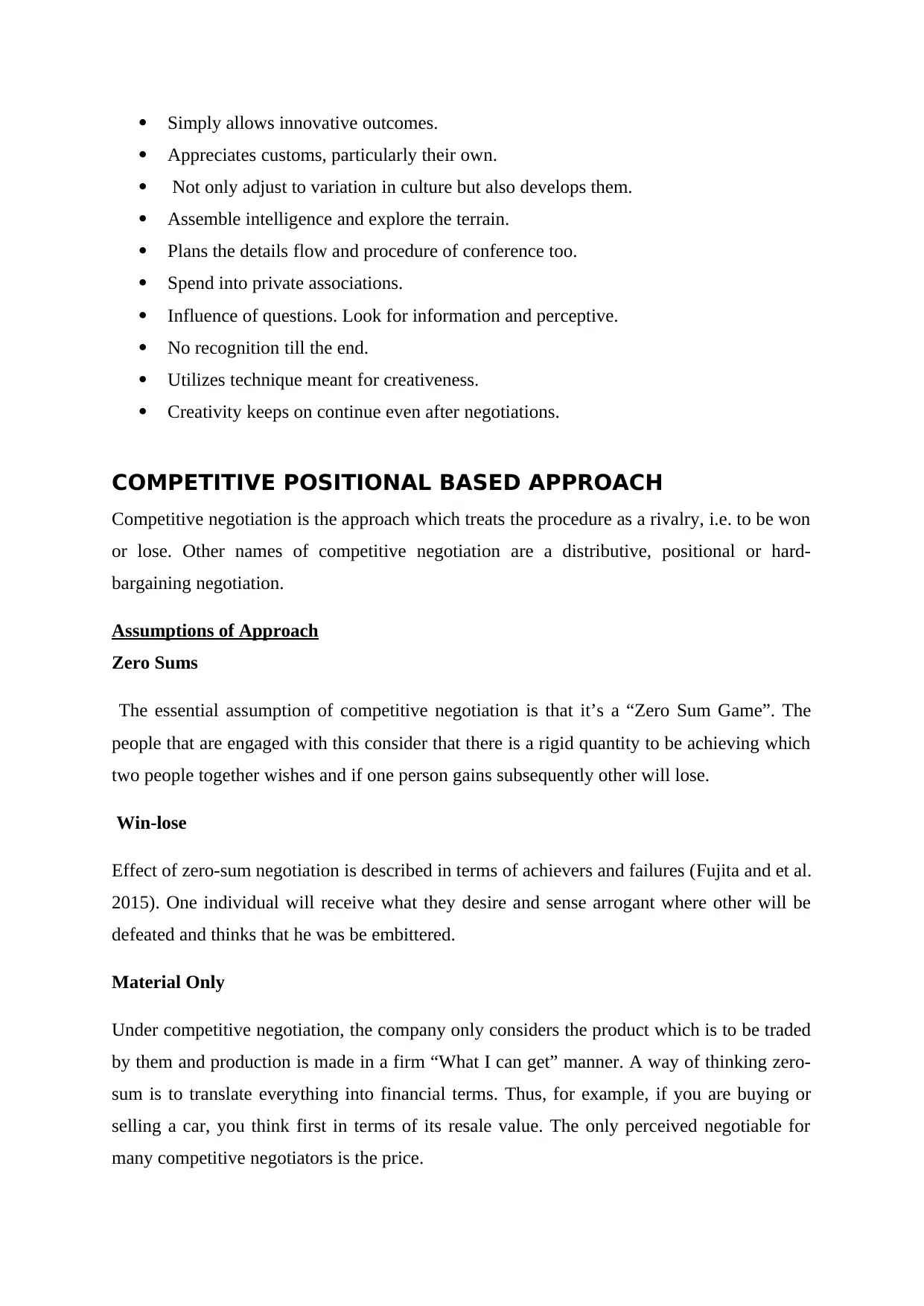
Simply allows innovative outcomes.
Appreciates customs, particularly their own.
Not only adjust to variation in culture but also develops them.
Assemble intelligence and explore the terrain.
Plans the details flow and procedure of conference too.
Spend into private associations.
Influence of questions. Look for information and perceptive.
No recognition till the end.
Utilizes technique meant for creativeness.
Creativity keeps on continue even after negotiations.
COMPETITIVE POSITIONAL BASED APPROACH
Competitive negotiation is the approach which treats the procedure as a rivalry, i.e. to be won
or lose. Other names of competitive negotiation are a distributive, positional or hard-
bargaining negotiation.
Assumptions of Approach
Zero Sums
The essential assumption of competitive negotiation is that it’s a “Zero Sum Game”. The
people that are engaged with this consider that there is a rigid quantity to be achieving which
two people together wishes and if one person gains subsequently other will lose.
Win-lose
Effect of zero-sum negotiation is described in terms of achievers and failures (Fujita and et al.
2015). One individual will receive what they desire and sense arrogant where other will be
defeated and thinks that he was be embittered.
Material Only
Under competitive negotiation, the company only considers the product which is to be traded
by them and production is made in a firm “What I can get” manner. A way of thinking zero-
sum is to translate everything into financial terms. Thus, for example, if you are buying or
selling a car, you think first in terms of its resale value. The only perceived negotiable for
many competitive negotiators is the price.
Appreciates customs, particularly their own.
Not only adjust to variation in culture but also develops them.
Assemble intelligence and explore the terrain.
Plans the details flow and procedure of conference too.
Spend into private associations.
Influence of questions. Look for information and perceptive.
No recognition till the end.
Utilizes technique meant for creativeness.
Creativity keeps on continue even after negotiations.
COMPETITIVE POSITIONAL BASED APPROACH
Competitive negotiation is the approach which treats the procedure as a rivalry, i.e. to be won
or lose. Other names of competitive negotiation are a distributive, positional or hard-
bargaining negotiation.
Assumptions of Approach
Zero Sums
The essential assumption of competitive negotiation is that it’s a “Zero Sum Game”. The
people that are engaged with this consider that there is a rigid quantity to be achieving which
two people together wishes and if one person gains subsequently other will lose.
Win-lose
Effect of zero-sum negotiation is described in terms of achievers and failures (Fujita and et al.
2015). One individual will receive what they desire and sense arrogant where other will be
defeated and thinks that he was be embittered.
Material Only
Under competitive negotiation, the company only considers the product which is to be traded
by them and production is made in a firm “What I can get” manner. A way of thinking zero-
sum is to translate everything into financial terms. Thus, for example, if you are buying or
selling a car, you think first in terms of its resale value. The only perceived negotiable for
many competitive negotiators is the price.
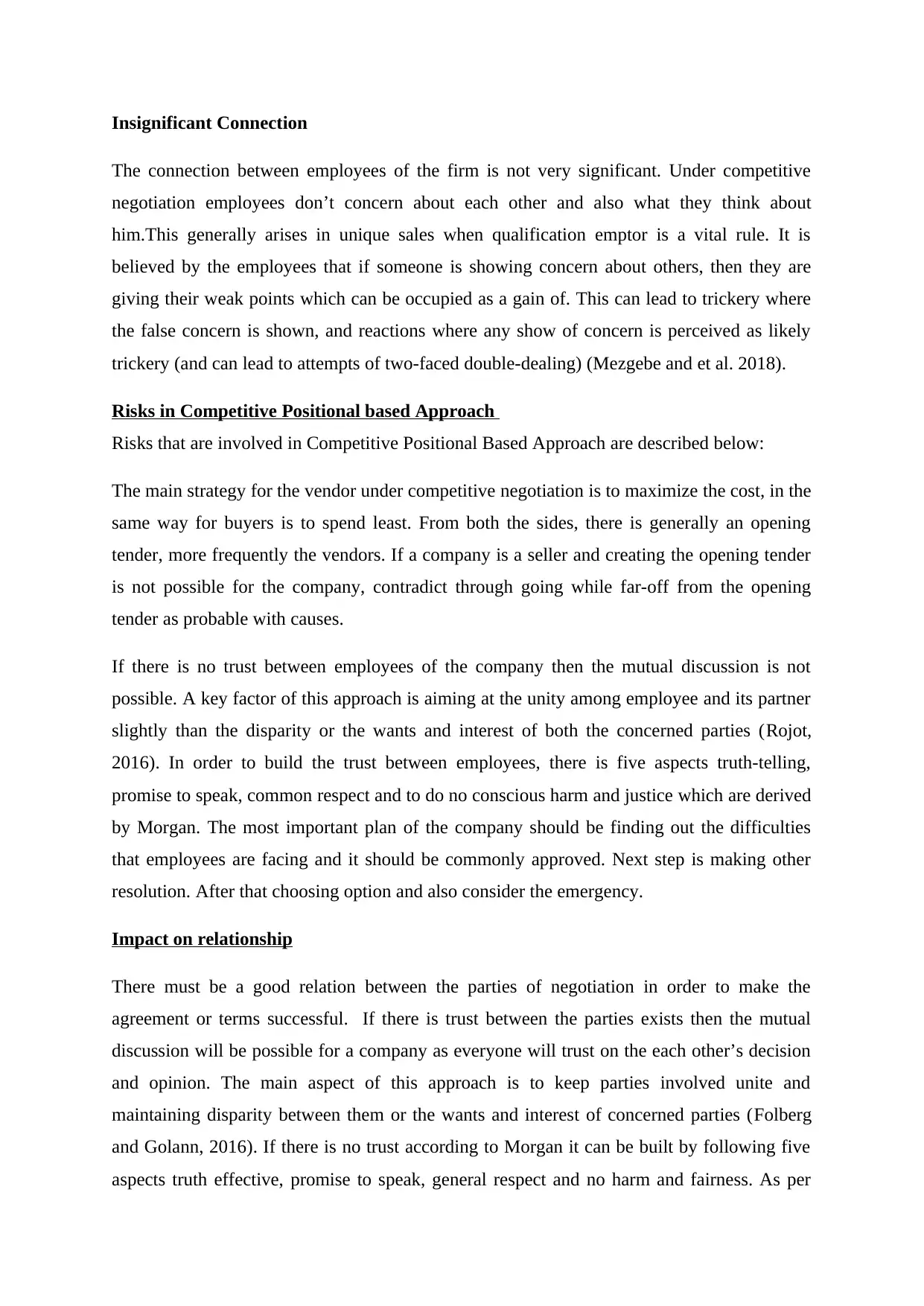
Insignificant Connection
The connection between employees of the firm is not very significant. Under competitive
negotiation employees don’t concern about each other and also what they think about
him.This generally arises in unique sales when qualification emptor is a vital rule. It is
believed by the employees that if someone is showing concern about others, then they are
giving their weak points which can be occupied as a gain of. This can lead to trickery where
the false concern is shown, and reactions where any show of concern is perceived as likely
trickery (and can lead to attempts of two-faced double-dealing) (Mezgebe and et al. 2018).
Risks in Competitive Positional based Approach
Risks that are involved in Competitive Positional Based Approach are described below:
The main strategy for the vendor under competitive negotiation is to maximize the cost, in the
same way for buyers is to spend least. From both the sides, there is generally an opening
tender, more frequently the vendors. If a company is a seller and creating the opening tender
is not possible for the company, contradict through going while far-off from the opening
tender as probable with causes.
If there is no trust between employees of the company then the mutual discussion is not
possible. A key factor of this approach is aiming at the unity among employee and its partner
slightly than the disparity or the wants and interest of both the concerned parties (Rojot,
2016). In order to build the trust between employees, there is five aspects truth-telling,
promise to speak, common respect and to do no conscious harm and justice which are derived
by Morgan. The most important plan of the company should be finding out the difficulties
that employees are facing and it should be commonly approved. Next step is making other
resolution. After that choosing option and also consider the emergency.
Impact on relationship
There must be a good relation between the parties of negotiation in order to make the
agreement or terms successful. If there is trust between the parties exists then the mutual
discussion will be possible for a company as everyone will trust on the each other’s decision
and opinion. The main aspect of this approach is to keep parties involved unite and
maintaining disparity between them or the wants and interest of concerned parties (Folberg
and Golann, 2016). If there is no trust according to Morgan it can be built by following five
aspects truth effective, promise to speak, general respect and no harm and fairness. As per
The connection between employees of the firm is not very significant. Under competitive
negotiation employees don’t concern about each other and also what they think about
him.This generally arises in unique sales when qualification emptor is a vital rule. It is
believed by the employees that if someone is showing concern about others, then they are
giving their weak points which can be occupied as a gain of. This can lead to trickery where
the false concern is shown, and reactions where any show of concern is perceived as likely
trickery (and can lead to attempts of two-faced double-dealing) (Mezgebe and et al. 2018).
Risks in Competitive Positional based Approach
Risks that are involved in Competitive Positional Based Approach are described below:
The main strategy for the vendor under competitive negotiation is to maximize the cost, in the
same way for buyers is to spend least. From both the sides, there is generally an opening
tender, more frequently the vendors. If a company is a seller and creating the opening tender
is not possible for the company, contradict through going while far-off from the opening
tender as probable with causes.
If there is no trust between employees of the company then the mutual discussion is not
possible. A key factor of this approach is aiming at the unity among employee and its partner
slightly than the disparity or the wants and interest of both the concerned parties (Rojot,
2016). In order to build the trust between employees, there is five aspects truth-telling,
promise to speak, common respect and to do no conscious harm and justice which are derived
by Morgan. The most important plan of the company should be finding out the difficulties
that employees are facing and it should be commonly approved. Next step is making other
resolution. After that choosing option and also consider the emergency.
Impact on relationship
There must be a good relation between the parties of negotiation in order to make the
agreement or terms successful. If there is trust between the parties exists then the mutual
discussion will be possible for a company as everyone will trust on the each other’s decision
and opinion. The main aspect of this approach is to keep parties involved unite and
maintaining disparity between them or the wants and interest of concerned parties (Folberg
and Golann, 2016). If there is no trust according to Morgan it can be built by following five
aspects truth effective, promise to speak, general respect and no harm and fairness. As per
⊘ This is a preview!⊘
Do you want full access?
Subscribe today to unlock all pages.

Trusted by 1+ million students worldwide
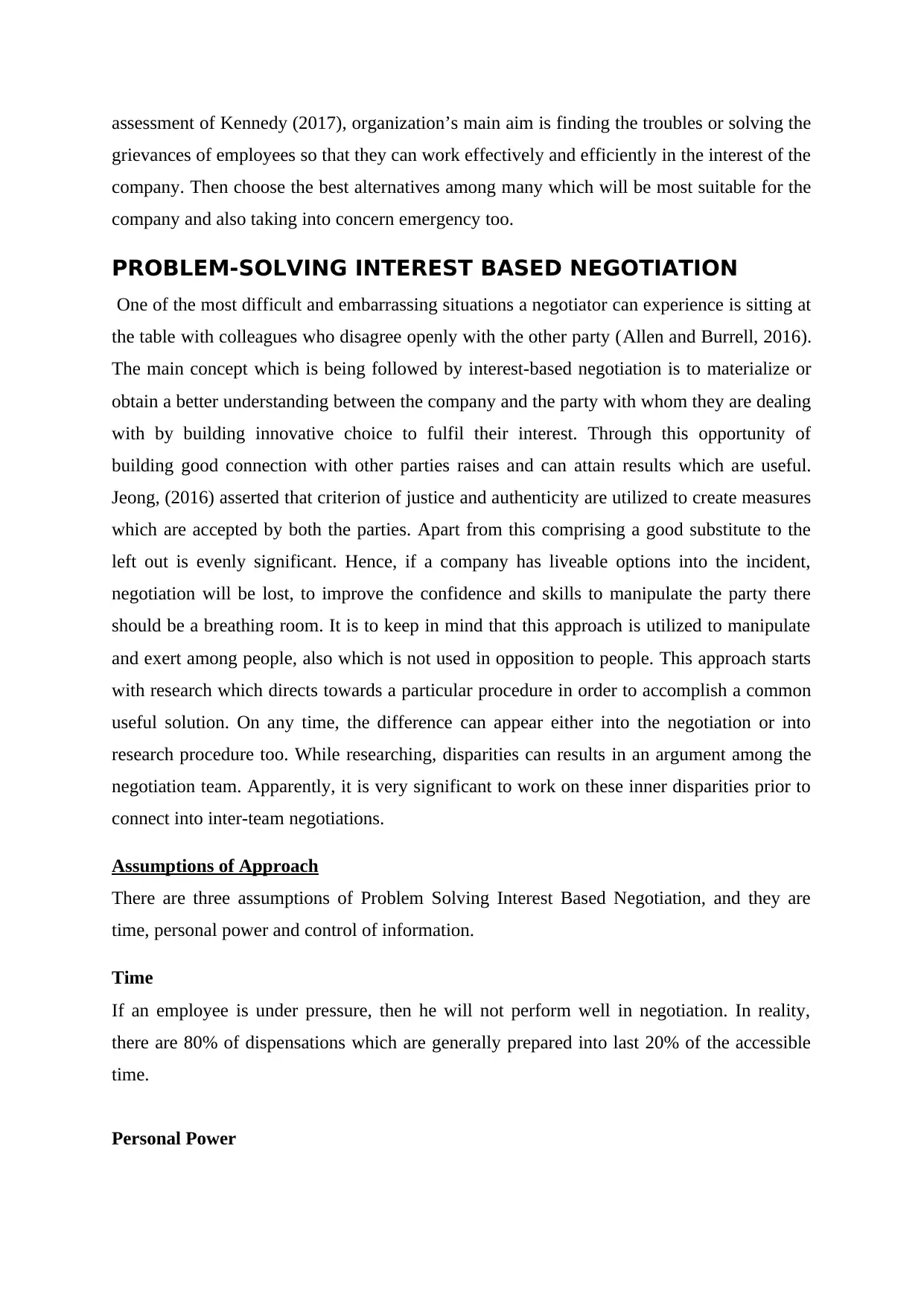
assessment of Kennedy (2017), organization’s main aim is finding the troubles or solving the
grievances of employees so that they can work effectively and efficiently in the interest of the
company. Then choose the best alternatives among many which will be most suitable for the
company and also taking into concern emergency too.
PROBLEM-SOLVING INTEREST BASED NEGOTIATION
One of the most difficult and embarrassing situations a negotiator can experience is sitting at
the table with colleagues who disagree openly with the other party (Allen and Burrell, 2016).
The main concept which is being followed by interest-based negotiation is to materialize or
obtain a better understanding between the company and the party with whom they are dealing
with by building innovative choice to fulfil their interest. Through this opportunity of
building good connection with other parties raises and can attain results which are useful.
Jeong, (2016) asserted that criterion of justice and authenticity are utilized to create measures
which are accepted by both the parties. Apart from this comprising a good substitute to the
left out is evenly significant. Hence, if a company has liveable options into the incident,
negotiation will be lost, to improve the confidence and skills to manipulate the party there
should be a breathing room. It is to keep in mind that this approach is utilized to manipulate
and exert among people, also which is not used in opposition to people. This approach starts
with research which directs towards a particular procedure in order to accomplish a common
useful solution. On any time, the difference can appear either into the negotiation or into
research procedure too. While researching, disparities can results in an argument among the
negotiation team. Apparently, it is very significant to work on these inner disparities prior to
connect into inter-team negotiations.
Assumptions of Approach
There are three assumptions of Problem Solving Interest Based Negotiation, and they are
time, personal power and control of information.
Time
If an employee is under pressure, then he will not perform well in negotiation. In reality,
there are 80% of dispensations which are generally prepared into last 20% of the accessible
time.
Personal Power
grievances of employees so that they can work effectively and efficiently in the interest of the
company. Then choose the best alternatives among many which will be most suitable for the
company and also taking into concern emergency too.
PROBLEM-SOLVING INTEREST BASED NEGOTIATION
One of the most difficult and embarrassing situations a negotiator can experience is sitting at
the table with colleagues who disagree openly with the other party (Allen and Burrell, 2016).
The main concept which is being followed by interest-based negotiation is to materialize or
obtain a better understanding between the company and the party with whom they are dealing
with by building innovative choice to fulfil their interest. Through this opportunity of
building good connection with other parties raises and can attain results which are useful.
Jeong, (2016) asserted that criterion of justice and authenticity are utilized to create measures
which are accepted by both the parties. Apart from this comprising a good substitute to the
left out is evenly significant. Hence, if a company has liveable options into the incident,
negotiation will be lost, to improve the confidence and skills to manipulate the party there
should be a breathing room. It is to keep in mind that this approach is utilized to manipulate
and exert among people, also which is not used in opposition to people. This approach starts
with research which directs towards a particular procedure in order to accomplish a common
useful solution. On any time, the difference can appear either into the negotiation or into
research procedure too. While researching, disparities can results in an argument among the
negotiation team. Apparently, it is very significant to work on these inner disparities prior to
connect into inter-team negotiations.
Assumptions of Approach
There are three assumptions of Problem Solving Interest Based Negotiation, and they are
time, personal power and control of information.
Time
If an employee is under pressure, then he will not perform well in negotiation. In reality,
there are 80% of dispensations which are generally prepared into last 20% of the accessible
time.
Personal Power
Paraphrase This Document
Need a fresh take? Get an instant paraphrase of this document with our AI Paraphraser
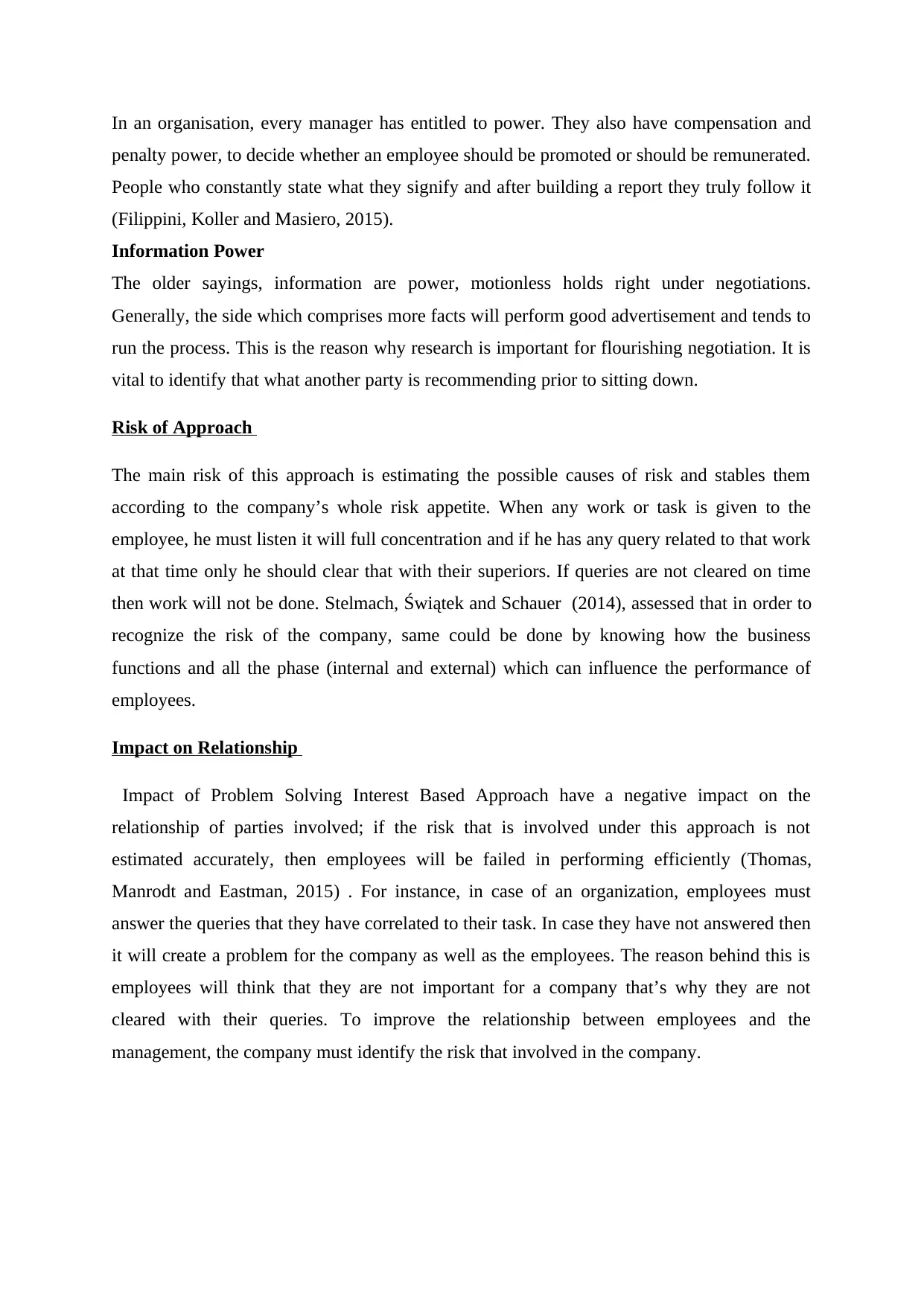
In an organisation, every manager has entitled to power. They also have compensation and
penalty power, to decide whether an employee should be promoted or should be remunerated.
People who constantly state what they signify and after building a report they truly follow it
(Filippini, Koller and Masiero, 2015).
Information Power
The older sayings, information are power, motionless holds right under negotiations.
Generally, the side which comprises more facts will perform good advertisement and tends to
run the process. This is the reason why research is important for flourishing negotiation. It is
vital to identify that what another party is recommending prior to sitting down.
Risk of Approach
The main risk of this approach is estimating the possible causes of risk and stables them
according to the company’s whole risk appetite. When any work or task is given to the
employee, he must listen it will full concentration and if he has any query related to that work
at that time only he should clear that with their superiors. If queries are not cleared on time
then work will not be done. Stelmach, Świątek and Schauer (2014), assessed that in order to
recognize the risk of the company, same could be done by knowing how the business
functions and all the phase (internal and external) which can influence the performance of
employees.
Impact on Relationship
Impact of Problem Solving Interest Based Approach have a negative impact on the
relationship of parties involved; if the risk that is involved under this approach is not
estimated accurately, then employees will be failed in performing efficiently (Thomas,
Manrodt and Eastman, 2015) . For instance, in case of an organization, employees must
answer the queries that they have correlated to their task. In case they have not answered then
it will create a problem for the company as well as the employees. The reason behind this is
employees will think that they are not important for a company that’s why they are not
cleared with their queries. To improve the relationship between employees and the
management, the company must identify the risk that involved in the company.
penalty power, to decide whether an employee should be promoted or should be remunerated.
People who constantly state what they signify and after building a report they truly follow it
(Filippini, Koller and Masiero, 2015).
Information Power
The older sayings, information are power, motionless holds right under negotiations.
Generally, the side which comprises more facts will perform good advertisement and tends to
run the process. This is the reason why research is important for flourishing negotiation. It is
vital to identify that what another party is recommending prior to sitting down.
Risk of Approach
The main risk of this approach is estimating the possible causes of risk and stables them
according to the company’s whole risk appetite. When any work or task is given to the
employee, he must listen it will full concentration and if he has any query related to that work
at that time only he should clear that with their superiors. If queries are not cleared on time
then work will not be done. Stelmach, Świątek and Schauer (2014), assessed that in order to
recognize the risk of the company, same could be done by knowing how the business
functions and all the phase (internal and external) which can influence the performance of
employees.
Impact on Relationship
Impact of Problem Solving Interest Based Approach have a negative impact on the
relationship of parties involved; if the risk that is involved under this approach is not
estimated accurately, then employees will be failed in performing efficiently (Thomas,
Manrodt and Eastman, 2015) . For instance, in case of an organization, employees must
answer the queries that they have correlated to their task. In case they have not answered then
it will create a problem for the company as well as the employees. The reason behind this is
employees will think that they are not important for a company that’s why they are not
cleared with their queries. To improve the relationship between employees and the
management, the company must identify the risk that involved in the company.
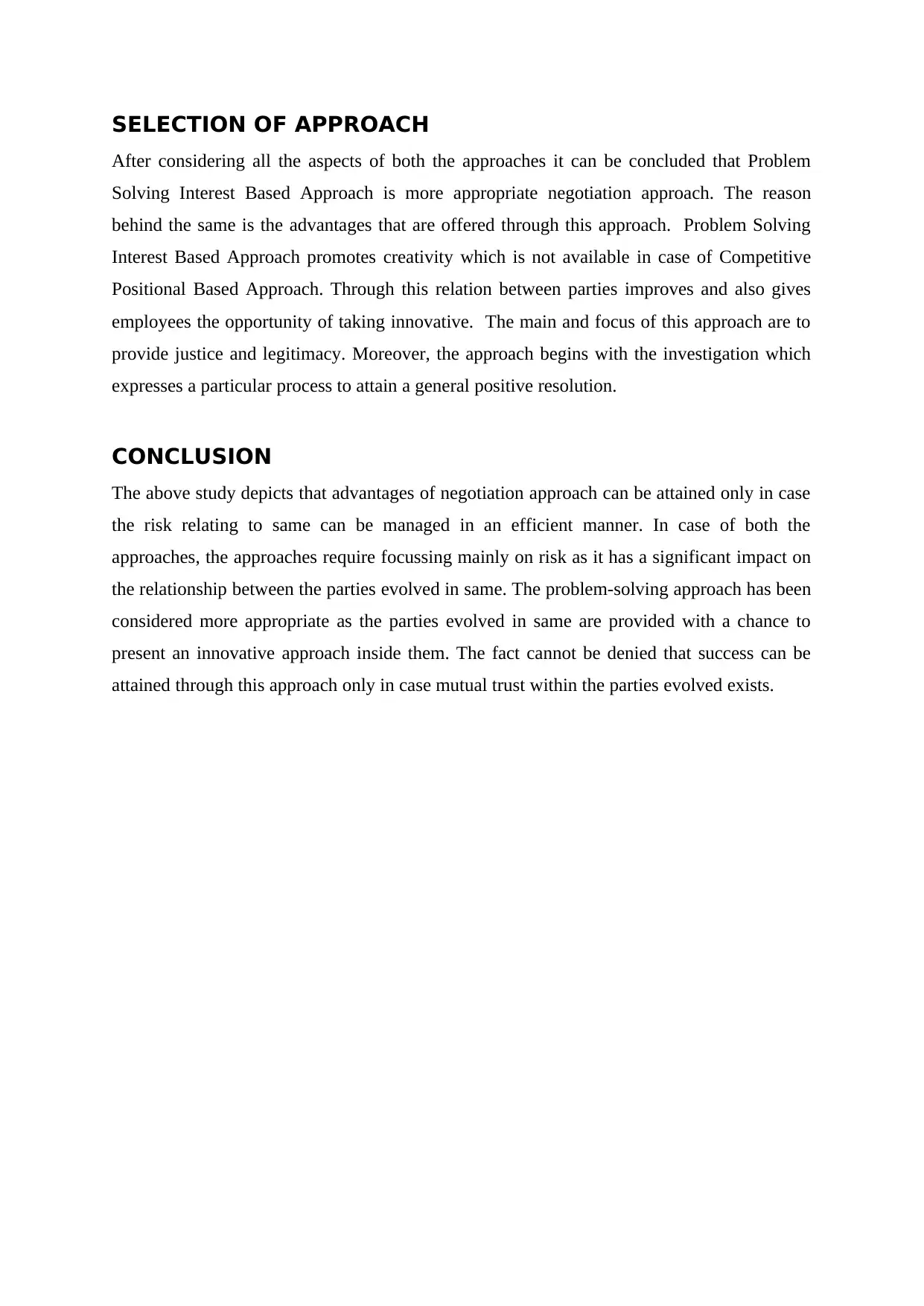
SELECTION OF APPROACH
After considering all the aspects of both the approaches it can be concluded that Problem
Solving Interest Based Approach is more appropriate negotiation approach. The reason
behind the same is the advantages that are offered through this approach. Problem Solving
Interest Based Approach promotes creativity which is not available in case of Competitive
Positional Based Approach. Through this relation between parties improves and also gives
employees the opportunity of taking innovative. The main and focus of this approach are to
provide justice and legitimacy. Moreover, the approach begins with the investigation which
expresses a particular process to attain a general positive resolution.
CONCLUSION
The above study depicts that advantages of negotiation approach can be attained only in case
the risk relating to same can be managed in an efficient manner. In case of both the
approaches, the approaches require focussing mainly on risk as it has a significant impact on
the relationship between the parties evolved in same. The problem-solving approach has been
considered more appropriate as the parties evolved in same are provided with a chance to
present an innovative approach inside them. The fact cannot be denied that success can be
attained through this approach only in case mutual trust within the parties evolved exists.
After considering all the aspects of both the approaches it can be concluded that Problem
Solving Interest Based Approach is more appropriate negotiation approach. The reason
behind the same is the advantages that are offered through this approach. Problem Solving
Interest Based Approach promotes creativity which is not available in case of Competitive
Positional Based Approach. Through this relation between parties improves and also gives
employees the opportunity of taking innovative. The main and focus of this approach are to
provide justice and legitimacy. Moreover, the approach begins with the investigation which
expresses a particular process to attain a general positive resolution.
CONCLUSION
The above study depicts that advantages of negotiation approach can be attained only in case
the risk relating to same can be managed in an efficient manner. In case of both the
approaches, the approaches require focussing mainly on risk as it has a significant impact on
the relationship between the parties evolved in same. The problem-solving approach has been
considered more appropriate as the parties evolved in same are provided with a chance to
present an innovative approach inside them. The fact cannot be denied that success can be
attained through this approach only in case mutual trust within the parties evolved exists.
⊘ This is a preview!⊘
Do you want full access?
Subscribe today to unlock all pages.

Trusted by 1+ million students worldwide
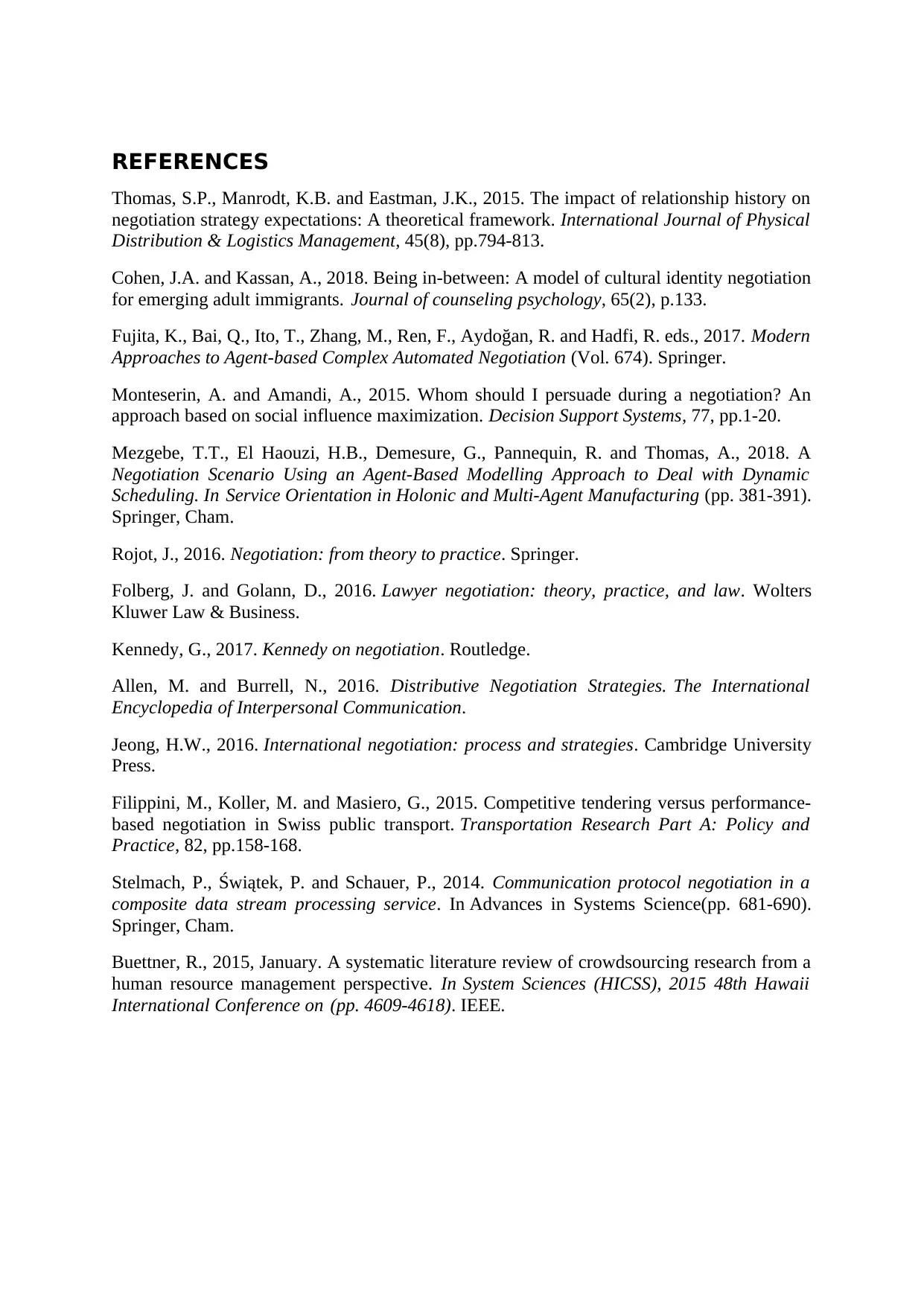
REFERENCES
Thomas, S.P., Manrodt, K.B. and Eastman, J.K., 2015. The impact of relationship history on
negotiation strategy expectations: A theoretical framework. International Journal of Physical
Distribution & Logistics Management, 45(8), pp.794-813.
Cohen, J.A. and Kassan, A., 2018. Being in-between: A model of cultural identity negotiation
for emerging adult immigrants. Journal of counseling psychology, 65(2), p.133.
Fujita, K., Bai, Q., Ito, T., Zhang, M., Ren, F., Aydoğan, R. and Hadfi, R. eds., 2017. Modern
Approaches to Agent-based Complex Automated Negotiation (Vol. 674). Springer.
Monteserin, A. and Amandi, A., 2015. Whom should I persuade during a negotiation? An
approach based on social influence maximization. Decision Support Systems, 77, pp.1-20.
Mezgebe, T.T., El Haouzi, H.B., Demesure, G., Pannequin, R. and Thomas, A., 2018. A
Negotiation Scenario Using an Agent-Based Modelling Approach to Deal with Dynamic
Scheduling. In Service Orientation in Holonic and Multi-Agent Manufacturing (pp. 381-391).
Springer, Cham.
Rojot, J., 2016. Negotiation: from theory to practice. Springer.
Folberg, J. and Golann, D., 2016. Lawyer negotiation: theory, practice, and law. Wolters
Kluwer Law & Business.
Kennedy, G., 2017. Kennedy on negotiation. Routledge.
Allen, M. and Burrell, N., 2016. Distributive Negotiation Strategies. The International
Encyclopedia of Interpersonal Communication.
Jeong, H.W., 2016. International negotiation: process and strategies. Cambridge University
Press.
Filippini, M., Koller, M. and Masiero, G., 2015. Competitive tendering versus performance-
based negotiation in Swiss public transport. Transportation Research Part A: Policy and
Practice, 82, pp.158-168.
Stelmach, P., Świątek, P. and Schauer, P., 2014. Communication protocol negotiation in a
composite data stream processing service. In Advances in Systems Science(pp. 681-690).
Springer, Cham.
Buettner, R., 2015, January. A systematic literature review of crowdsourcing research from a
human resource management perspective. In System Sciences (HICSS), 2015 48th Hawaii
International Conference on (pp. 4609-4618). IEEE.
Thomas, S.P., Manrodt, K.B. and Eastman, J.K., 2015. The impact of relationship history on
negotiation strategy expectations: A theoretical framework. International Journal of Physical
Distribution & Logistics Management, 45(8), pp.794-813.
Cohen, J.A. and Kassan, A., 2018. Being in-between: A model of cultural identity negotiation
for emerging adult immigrants. Journal of counseling psychology, 65(2), p.133.
Fujita, K., Bai, Q., Ito, T., Zhang, M., Ren, F., Aydoğan, R. and Hadfi, R. eds., 2017. Modern
Approaches to Agent-based Complex Automated Negotiation (Vol. 674). Springer.
Monteserin, A. and Amandi, A., 2015. Whom should I persuade during a negotiation? An
approach based on social influence maximization. Decision Support Systems, 77, pp.1-20.
Mezgebe, T.T., El Haouzi, H.B., Demesure, G., Pannequin, R. and Thomas, A., 2018. A
Negotiation Scenario Using an Agent-Based Modelling Approach to Deal with Dynamic
Scheduling. In Service Orientation in Holonic and Multi-Agent Manufacturing (pp. 381-391).
Springer, Cham.
Rojot, J., 2016. Negotiation: from theory to practice. Springer.
Folberg, J. and Golann, D., 2016. Lawyer negotiation: theory, practice, and law. Wolters
Kluwer Law & Business.
Kennedy, G., 2017. Kennedy on negotiation. Routledge.
Allen, M. and Burrell, N., 2016. Distributive Negotiation Strategies. The International
Encyclopedia of Interpersonal Communication.
Jeong, H.W., 2016. International negotiation: process and strategies. Cambridge University
Press.
Filippini, M., Koller, M. and Masiero, G., 2015. Competitive tendering versus performance-
based negotiation in Swiss public transport. Transportation Research Part A: Policy and
Practice, 82, pp.158-168.
Stelmach, P., Świątek, P. and Schauer, P., 2014. Communication protocol negotiation in a
composite data stream processing service. In Advances in Systems Science(pp. 681-690).
Springer, Cham.
Buettner, R., 2015, January. A systematic literature review of crowdsourcing research from a
human resource management perspective. In System Sciences (HICSS), 2015 48th Hawaii
International Conference on (pp. 4609-4618). IEEE.
Paraphrase This Document
Need a fresh take? Get an instant paraphrase of this document with our AI Paraphraser


⊘ This is a preview!⊘
Do you want full access?
Subscribe today to unlock all pages.

Trusted by 1+ million students worldwide
1 out of 12
Related Documents
Your All-in-One AI-Powered Toolkit for Academic Success.
+13062052269
info@desklib.com
Available 24*7 on WhatsApp / Email
![[object Object]](/_next/static/media/star-bottom.7253800d.svg)
Unlock your academic potential
Copyright © 2020–2025 A2Z Services. All Rights Reserved. Developed and managed by ZUCOL.




